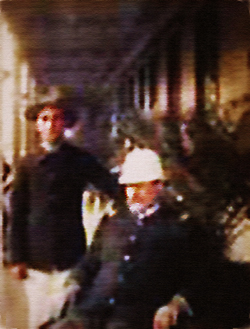 
Left: Colonel Jay L. Torrey, Torrey's Rocky Mountain Rough Riders;
Right: Spanish-American War Memorial, "Taking the Oath" on the southeast corner of the
Capitol Grounds, Cheyenne.
Torrey's Rocky Mountain Rough Riders was one of three privately organized volunteer cavalry regiments
for service in the Spanish-American War. The most famous of which was Theodore Roosevelt's
Rough Riders. A third was a regiment organized by Colonel Melvin Grigsby, the attorney general of
South Dakota. Grigsby's unis awaited transportation to Cuba at the
disease ridden Camp Thomas at Chicamauga Park, Georgia. There many of the troops were overtaken by measels and other diseases.
By the time transport to Cuba was available, the Cuban War was over and the troops were mustered out.
The Spanish-American WAr Memorial reminds us of those who fought in both Cuba and in the Philippines as well as those who died on the way to
Cuba as a result of mishap or disease.
The plaque on the base of the Spanish-American War Memorial reads:
Erected to the Memory of
The Heros of the Spanish
American War
By
The State of Wyoming
And
The Ladies Volunteer Aid
Society
The Statue is the oldest on the Capitol Grounds and was dedicated on January 26, 1905. by Governor B. B. Brooks
who transmitted a formal letter to the Legislature requesting that they take brief pause from their labors to attend.
The memorial is unusual in that all across this
broad land there are very few memorials outside of an occasional cemetery dedicated solely to those who
fought in the Spanish-American War. Although there are memorials dedicated to those who died in earlier wars, subsequent memorials are dedicated to
those who fought in all wars. Units of the Wyoming National Guard served in the
Philippines. Some volunteers such as Dr. Amos W. Barber from Wyoming served in Cuba. In Cheyenne, at one time there were two memorials, the one depicted above and
a second now removed at F. E. Warren Air Force Base, depicted on the previous page. The bulk of the men from Wyoming
trained at Ft. D. A. Russell. The Doughboy memorial in Evanston is dedicated to both
the veterans of the Spanish-American War and World War I.
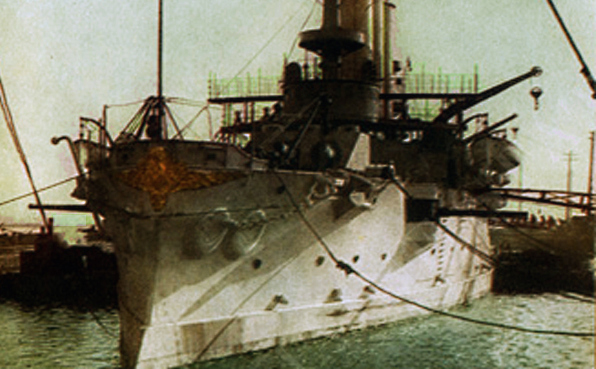
The Battleship Maine.
On February 15, 1898, the USS Maine was paying an alleged "goodwill" visit to Havana, Cuba. There had been insurrection on the island.
Two months earlier in December Admiral George Dewey had arrived in Hong Kong and in January he had been instructed to retain all enlisted men who terms of service had
expired. In Febrary he was instructed to fill all coal bunkers. In the meantime, Amunition ships had been dispatched from the United States to join Admiral Dewey. Soon,
Admiral Dewey had in Hong Kong in addition to his flaghip the Olympia, th Baltimore, the Raleigh, the Concord, the Petrel and the Boston. By March he had purchased two British-owned
steamships which he converted to amunition carriers.
As to Cuba, American public opinion was in favor of the
rebels due to the alleged harshness with which the Spanish government was putting down the rebellion. On February 15, 1898, an explosion or fire on
board the vessel apparently set off a second explosion in the ammunition magazine. The ship sank with a loss of 260 officers and men. The actual cause of the
explosion has never been fully determined. Whether it was from an external mine or an internal fire and if from a mine
whether it was set off by the rebels seeking to draw the United States into the insurrection or
by the Spanish government remains unknown. The American press was quick to blame Spain, "Remember the Maine, to Hell with Spain" became the war cry. Things became
testy between the United States and the Spanish government. On April 13, Congress demanded that
Spain recognize the independence of Cuba and withdraw all forces from the Island. Congress authorized force. On April 24,
Spain declared war. The following day, the United States reciprocated and Admiral Dewey set sail for the Philippines with coal bunkersand anumunition magazines well filed accompanied by his entire fleet and
two supply ships also well filled with additional coal and annumition. The whole fleet was newly painted
in war time gray. The only ones that did not know that war was coming were Spanish officials on Guam. When the first expedition from
Hawaii was passing Guan, several shots were filed at an abandoned Spanish fort. The Spanish governor of the island came out to thank the
fleet for the salute and apologize that he could not return the salute, but he had no annumition. He was promptly taken
prisoner and informed he was a prisoner of war. It was the first he heard that Spain and the United States were at war.
At the beginning of he War, the United States was woefully unprepared. consisted of only
28,000 troops. On March 31, Governor William Richards telegraphed Presient McKinley that the Wyoming National Guard was ready for service at the
President's call.
At Ft. D. A. Russell beginning in May, 1898, former Wyoming State Legislator Jay L. Torrey, pursuant to legislation pushed through Congress of
Senator F. E. Warren, organized the 2nd United States Volunteers, "Torrey's Rough Riders.' Torry managed the Em Bar Ranch on Owl Creek near
Thermopolis. Although predominately consisted of cowboys from Wyoming and Utah, the Rough Riders also had men from
Idaho and Colorado. Units of the wyoming National Guard were also encamped at D. A. Russell as well as at
Camp Richards named for Governor Richards. Camp Richards was located about where
Frontier Park is now located a short distance north of Cheyenne.
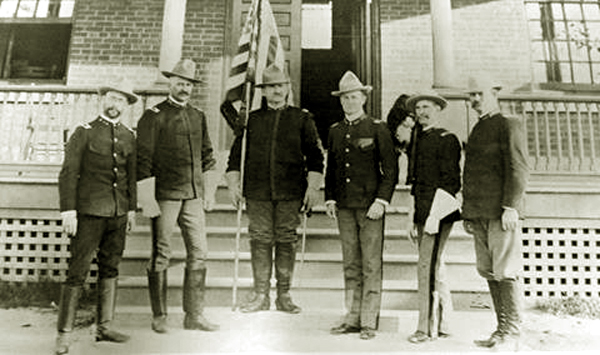
Officers of Torrey's Rough Riders at Fort D. A. Russell.
Left to Right: Major Mortimer Jesurun, Surgeon; Lt. Col. John Q. Conner; Col. Jay L. Torrey; Major James Harbord; Major William Wheeler; Major Robert Caverley.
Major Jesrun was from Converse County. Lt. Col. Conner was from Salt Lake City. Major Harbord transfer to the regular army and was
assigned to Cuba. Later he served in the Philippines as Assistant Chief Constable in the Philippine Constabulary from 1903 to 1913. Thereafter
her served along the Mexican Border and participated in Pershing's pursuit of
Pancho Villa. When the United States entered World War I, he saw service under General Pershing in France. He retired as a
Major General. Major Wheeler was from Colorado. Major Calverley later operated a business in
Kemmerer.
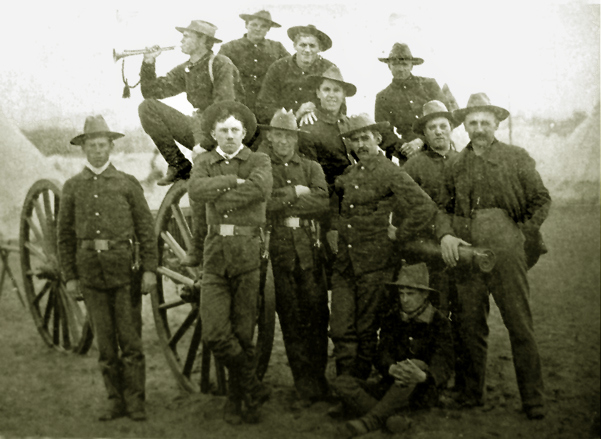
Gun Detachment, Torrey's Rough Riders
At first, it was anticipated that the Rough Riders would see service in Cuba and then it was anticpated that service was to
be in Puerto Rico. Finally, orders came through the units would go to Cuba and embark from Tampa. Tampa was selected over other ports thanks in
part due to lobbying by railroad magnate Henry Plant whose railroad served Tampa.
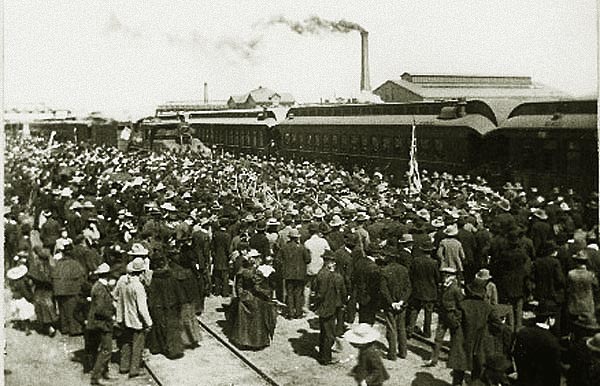
Crowd seeing troops of Torrey's Rough Riders ("Second United States Volunteer Cavalry") off for Cuba at the Cheyenne Union Pacific Depot, June 23, 1898.
A month before on May 18, 1898, a similar scene was enacted as discussed on the next page when Wyoming National Guard troops entrained for San Franciso to see
service in the Philippines.
The First Volunteers were organized by Col. Leonard Wood and former
Assistant Secretary of the Navy Theodore Roosevelt and the Third by South Dakota Attorney General Melvin Grigsby. Three days following the
above photo, one of the four trains heading to Florida for embarcation for Cuba paused for to take on water near Tupelo, Mississippi. To the north of the
water tank the tracks curved obscuring view of the earlier stopped train. A following train bearing additional troops rounded the curve. It was too late to stop.
The second train collided with the rear of the first train killing and injuring a number of men.
Among those injured was Col. Torrey.
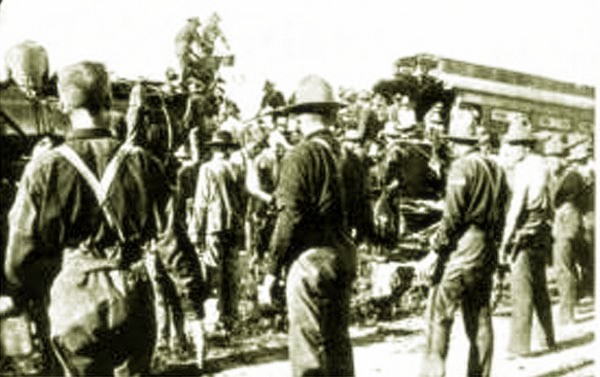
Train wreck at Tupelo, Mississippi, June 26, 1898.
The result of the wreck was a delay of several weeks in Col. Torrey's units from reaching
Florida. By that time, troop transports had already left Tampa. Indeed, as noted later on this
website, Col. Roosevelt was required, in essence, to steal transport in Tampa and had to leave his horses behind. Torrey's units were then
encamped at Pablo Beach, Florida (now Jacksonville Beach) and Panama Park seven miles from Jacksonville on the St. Johns River,"to far for social entertainment." There the troop
continued training in the event they were needed.
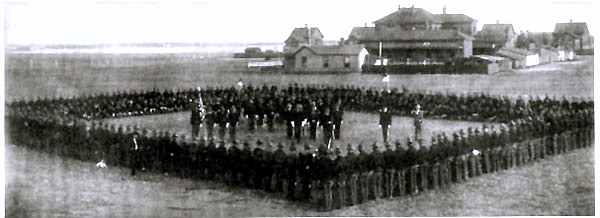
Torrey's Rough Riders receiving their shoulder straps.
In the summer,
Pablo Beach was a pestilent, mosquito and rattlesnake invested stretch of sand dunes bordered on the west by salt water marshes in which the disease spreading mosquitoes flourished.
Panama Park was described by Daniel Ott in "Remember the Main! Adams County's [Nebraska] Involvement in the
Spanish American War" as:
"Not only was it too far from town for social entertainment.
The soldiers were camped on a sandy plain with no natural shelter from
the blistering sun. 'Itís a 120 degrees in the shade,' remarked a soldier before drill. 'Yes, and no shade!' added Frank ("The Count") Lepinski, the company jokester.
The only defense from the torrid heat was the nearby St. Johnís River, where the men found great comfort in swimming until a fourteen foot long alligator
was captured in the stream. From then on the Nebraska boys gave up bathing in the vicinity.
In the exposed desert of Panama Park many suffered from dysentery and other heat related illnesses, but
luckily none from Company K were lost. John ("Frank") Kealy
(Dr. Donovan B. Footeís father-in law) later reflected on conditions he
experienced while stationed in Florida: "Our camps were laid out with
the row of company cook tents (no fly screens) next to the open latrines
and we sat around there in the sand to eat whatever was dished up to us
with one hand while using the other to brush flies. Even after a lot of
deaths from typhoid, dysentery, etc. there was nothing done about it.
Panama Park was located on the St. Johns River about two miles south of the mouth of Trout Creek.
Ten years before, an epidemic of
yellow fever, the "black vomit," had broken out in the area. Residents fled but were turned away by neighboring towns at gun point. One town would not even allow
passenger trains from Jacksonville to pass through. Until a killing frost killed the mosquitoes, the population of
Jacksonville fell from 130,000 to 14,000.
Among the troops at Pablo Beach an epidemic of Typhoid broke out. At the time,
Army physcians were not necessarily able to distinquish between malaria caused by mosquitoes and typhoid.
Discovery that disease was spread by mosquitoes was generally not known until after the end of the War.
The Sheriff of Duval County (Jacksonville), Napoleon Bonaparte Broward, was elected as
Governor of Floria amd is known as the father of mosquito control in the state. To him is attributed much of the draining of the
Everglades. Broward County is named for him as well as a bridge in Jacksonville. Some environmentalists
now advocate restoring parts of the Everglades. Until mosquito control, most of south Florida was regarded as
uninhabitable.
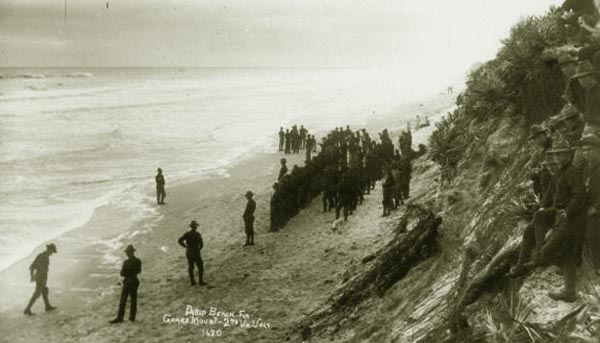
Guard Mount, Virginia Volunteers, Pablo Beach, 1898. Photo Courtsy Florida Bureau of Archives.
More than ten times the number of American troops in Florida and the Spanish Antilles died from the
effects of tropical disease than from Spanish action.
Many of those who fell ill in Tampa were transferred to Georgia but there was a shortage of
hospital trains. Those who fell ill in Pablo Beach were housed in hospital tents. Regular housing also consisted of tents.
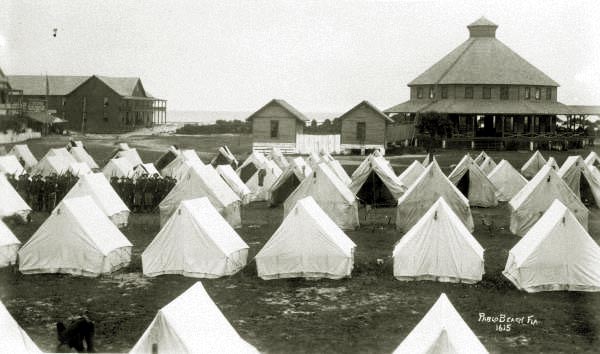
Military tents at Pablo Beach, 1898. Photo Courtsy Florida Bureau of Archives.
To make matters worse, on October 2, a tropical hurricane passed off the coast of
Pablo Beach and came ashore about fifty miles north at Cumberland Island, Georgia.
The storm is now believed by the United States weather service to have had winds of 135 mles per hour and based on the grounding of
a pilot boat on Cumberland Island a storm surge of twenty feet. See Al Sendrik and Brian Jarvinen, "A reevaluation of the Georgia and Northeast
Florida tropical Cyclone of 2 October 1898, National Weather service Weather Forcast Office, Jacksonville, Fl, 2010. Contemporeous reports indicated that
hurricane signals were hoisted in Jacksonville at 7:00 a.m. on the 2nd. The maximum winds from the storm were reached in Jacksonville at 11:10 a.m. The town of Fernandina about
25 north of Pablo Beach was, in a report by A. J. Mitchell directors of the Weather Bureau in Jacksonville, "was nearly destroyed" with boats at anchor foundered or were blown into the marshes."
Telegraph lines from Savannah to St. Augustine were "prostrated" and many miles of railroad track were washed away. See Abbe, Cleveland: Monthly Weather Review, October 1898, "The
West Indian Hurricane of September 29-October 2."
Walter R.Sevens in "The Story of the Rough Riders," Leslie"s Weekly, May 5, 1900, wrote:
The rough riders were always tenderly solicitous as to their sick comradse. While in camp at Panama Park, Fla. there was a cyclone. As soon as
it was recognized, the men by common consent rushed to the hospital, and by thir combined strength perfectly protected from the
slightest inconvenience or injury. Many of the men sat upon the guy ropes and support the tent-poles were only partly dressed, and the tents of quite a large number of them
were blown away in their absence.
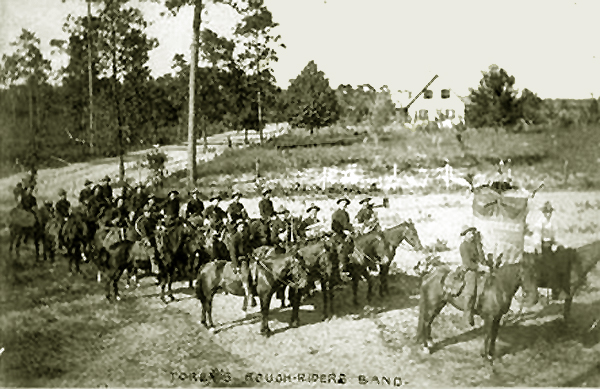
Band, Torrey's Rough Riders, believed to be near Jacksonville.
As a result of the storm and the flooding of Pablo Beach, the men were transferred to Fairfield on the curve of the St. Johns River to the northwest just to the
north of the present-day Buckman Bridge (I-295 Bridge).
In 1907, the area of the curve (Black Point) was designated by the
Florida Legislature as a state military camp. It later was designated as
Camp Joseph E. Johnston. During World War I it became a training camp for the Quarter Master Corps. It is now a part of the
Jacksonville Naval Air Station.
Respite from the heat was obtained by swimming in a nearby lake until it was discovered that
the lake was being shared with alligators.
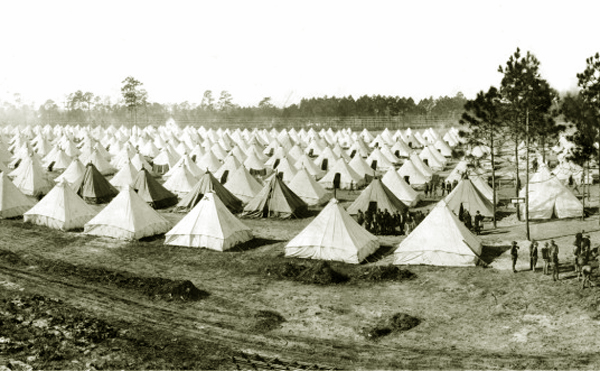
Camp Joseph E. Johnston, approx. 1916.
The men were mustered out at Jacksonville on Coctober 24. Some returned home, others, wrote Stevens, enlisted for service in the Philippines and others enlisted in
British forces for service in South Africa and some others with the
Boers.
Next page, Spanish-American War in the Philippines.
|